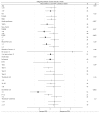Pharyngeal Electrical Stimulation for Treatment of Poststroke Dysphagia: Individual Patient Data Meta-Analysis of Randomised Controlled Trials
- PMID: 26689491
- PMCID: PMC4672134
- DOI: 10.1155/2015/429053
Pharyngeal Electrical Stimulation for Treatment of Poststroke Dysphagia: Individual Patient Data Meta-Analysis of Randomised Controlled Trials
Abstract
Background. Dysphagia after stroke is common, associated independently with poor outcome, and has limited treatment options. Pharyngeal electrical stimulation (PES) is a novel treatment being evaluated for treatment of poststroke dysphagia. Methods. We searched electronically for randomised controlled trials of PES in dysphagic patients within 3 months of stroke. Individual patient data were analysed using regression, adjusted for trial, age, severity, and baseline score. The coprimary outcomes were radiological aspiration (penetration aspiration score, PAS) and clinical dysphagia (dysphagia severity rating scale, DSRS) at 2 weeks; secondary outcomes included functional outcome, death, and length of stay in hospital. Results. Three completed trials were identified: 73 patients, age 72 (12) years, severity (NIHSS) 11 (6), DSRS 6.7 (4.3), mean PAS 4.3 (1.8). Compared with no/sham stimulation, PES was associated with lower PAS, 3.4 (1.7) versus 4.1 (1.7), mean difference -0.9 (p = 0.020), and lower DSRS, 3.5 (3.8) versus 4.9 (4.4), mean difference -1.7 (p = 0.040). Length of stay in hospital tended to be shorter: 50.2 (25.3) versus 71.2 (60.4) days (p = 0.11). Functional outcome and death did not differ between treatment groups. Conclusions. PES was associated with less radiological aspiration and clinical dysphagia and possibly reduced length of stay in hospital across three small trials.
Figures



References
-
- Falsetti P., Acciai C., Palilla R., et al. Oropharyngeal dysphagia after stroke: incidence, diagnosis, and clinical predictors in patients admitted to a neurorehabilitation unit. Journal of Stroke & Cerebrovascular Diseases. 2009;18(5):329–335. doi: 10.1016/j.jstrokecerebrovasdis.2009.01.009. - DOI - PubMed
Publication types
Grants and funding
LinkOut - more resources
Full Text Sources
Other Literature Sources

